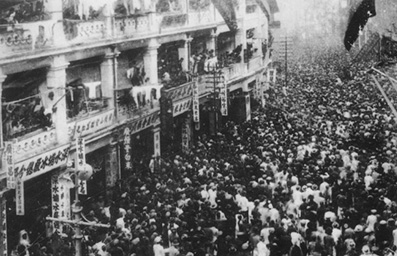 |
Peoples' movements and protests |
 |
|
Mobilizations16-17 century piracyThe slave uprising in HaitiThe Chartists1848The First internationalThe Social Democratic PartyThe Revolutions 1917-19General strike in Hong Kong 1925-26The occupation of FlintThe welfare statePeronismThe boom of the 60s-70s in EuropeSolidarnoscThe metal strike in São PauloThe Hyundai strikeBack to Labour MovementsBack to main page |
The general strike in Hong Kong
In the early 1920s, all those who sought to free China from colonial dependence established a counter-republic in Guangzhou. In practice, this meant an alliance between the Shanghai bourgeoisie organized in the Kuomintang and the Communist Party, the latter supported by the so-called The May 4 movement, a youth uprising against outdated Confucianism. The Communists were mainly engaged in organizing the lower class for the defense of the republic while the bourgeoisie ran the business. Of course, one part of such is the trade union. Central to both was the trade union organization in Hong Kong, the colonialists' stronghold in East Asia. In 1922, the sailors went on strike and had great success since they received support from the dock workers. Around this, the unions were then built up. In 1925 it was time again. By then, the unions in Shanghai had gone on strike in protest against killing of trade unionists, and the conflict spread to Hong Kong, where the unions went on general strike. The strike was fantastically well organized, with financial support organized among Chinese emigrants throughout Asia and the United States, with its own police, with schools to train the strikers in reading and politics, and with a boycott of all English goods. It is said that the city was so paralyzed that the upper class women themselves had to buy their own food. After a year, it was practically ruined. But then, people had had enough. Chinese merchans, of course, were fed up with not being able to trade with the British. But worse, Hongkong workers were also fed up with carrying the whole burden of Chinese anti-imperialism run by the Communist party. So the strike collapsed. In order to quickly find a compromise, the bourgeoisie and the communists decided to instead of popular organization invest in military conquest of China and started the so-called Northern expedition. It was very successful, but when the Kuomintang controlled the Yangtze Valley in this way, it no longer needed the support of communists but could calmly begin to exterminate them in order to build its own dictatorship. And in the future, the Communist Party / National Movement invested in the peasants as a more sustainable base. As a whole, the general strike in Hong Kong is a good example of the advantages and disadvantages of workers’ movements allying with national movements and alliances in general. If it goes well, it goes very well, but if the other party gets tired, it can go really bad.
Reading
|

